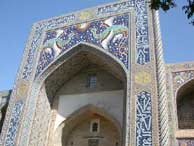| |






|
The Lyab-i Hauz (also Lyab-i Khauz) is the title given to the area
surrounding one of the few remaining Hauz or ponds surviving in the city of
Bukhara.
Until the Soviet period there were many such ponds, which were the city's
principal source of water, but they were notorious for spreading disease and
were mostly filled in during the 1920s and 30s. The Lyab-i Hauz survived because
it is the centrepiece of a magnificent architectural ensemble, created during
the 16th and 17th centuries, which has not been significantly changed since. The
Lyab-i Hauz ensemble consists of the Kukeldash madrasah (1568-1569)
(see picture 1), the largest in the city, and of
two religious edifices built by Nadir Divan-Begi: A Khanaka (1620) (see picture 2)
- a Khanaka is a lodging-house for itinerant Sufis - and a
Madrasah
(1622) (see picture 3) that stand at right
angles to each other. The small Qazi-e Kalyan Nasreddin madrasah (now
demolished) was formerly located beside the Kukeldash madrasah.
Note: All pictures can be enlarged.
The history of this ensemble is closely connected with the name of Nadir
Divan-Begi, who was an important grandee,
Vizier,
and also an uncle of the
Emir of Bukhara Imam Quli Khan. It is said that when Nadir Divan-Begi
built the Khanaka which bears his name, near the site of the building there was
a large holding owned by an old Jewish widow. Nadir Divan-Begi had decided that
this site would be the perfect place for pond. But the widow turned down his
offer to buy the property. Then Nadir Divan-Begi brought her before Imam Quli
Khan in the hope that the Emir would coerce her into selling. The Emir of
Bukhara ordered a congress of
muftis
to inquire into the question. However, these specialists in Muslim law decided
that there was no legal way to purchase the property, other than with the
widow's consent, since Jews had rights on a par with Muslims if they paid the
Jizyah or poll-tax on
non-Muslims.
Note:
Caliph
Umar ibn al-Khattab had forbidden the construction of new synagogues and the destruction of old ones that were existed in pre-Islamic period. There was a case when Caliph
Umar had ordered to destroy a mosque, which was built illegally on Jewish land. Jews (as well as Christians) had autonomic ruling with administrative leader, who was in charge for tax payments to Muslim administration. Institute of autonomic administration of Jewish Diaspora was created in 8 century. Same structure of tax payments would be settled in Samarkand in 400 years.
So, Nadir Divan-Begi had to build a small reservoir near the house of that
stubborn Jewess. But he dug an
aryk - an
irrigation ditch - to his new pond in such a way that the water ran right near
the Jewish widow's house, although it was more expensive. Soon the water began
to undermine the foundations of the widow's house. When she came to Nadir Divan-Begi
for justice, he confirmed his readiness to buy her house for fair price. But
widow rejected the money, laying down her own conditions instead. She promised
give up her property if the Bukharan rulers would give to her another piece of
land with permission to build a
synagogue.
In return for the widow’s holding Nadir Divan-Begi gave her a plot of land,
belonging to him, in residential area, which later was named the "Jewish
quarter" (Mahalli Kuma).
Soon the first synagogue at Bukhara and a large pond were built. People started
to call it the "Lyab-i Hauz" (see picture 4), which
means "at the pond". The date of its construction is about 1620. But folk memory
still retains another epithet - Haus-i Bazur "made with a force".
Today the Lyab-i Hauz is a right-angled pond (46 x 36 meters), which stretches
from the east to the west and is buried in the verdure of century-old trees. Its
edges are arranged in the form of the descending staircase made of massive
blocks of yellowish limestone.
Before the construction of the first synagogue Jews had shared a place in a
mosque with Muslims. This mosque was called the "Magak-i attari" (also
Magoki Attoron) (see picture 5), i.e. the "Mosque
in pit". Some say that Jews and Muslims worshipped alongside each other in the
same place at the same time. Other sources insist that Jews worshipped after
Muslims. This perhaps explains the
Bukharan
Jewish custom of saying "Shalom Aleyhim" ("Peace be with you") after
morning prayer. This custom is not found amongst European Jews.
Before the Arab
conquest there was a bazaar on the site of the Magak-i attari. It was a market
for idols, potions and spices -
attar
(perfumes) and other goods. Besides this, there was formerly a Temple of the
Moon (Mokh) close to this place. Narshakhi named the mosque, which was built on
the site of former temple, "magok", i.e. "in a pit", because even then half of
it was concealed from view by the rising soil level.
As stated above the Kukeldash Madrasah is the biggest in Bukhara (80 x 60
meters). Kulbala Kukeldash was the name of the Emir's foster-brother who was the
builder of this structure.
The Nadir Divan-Begi Madrasah was initially erected as a
caravanserai. At the inauguration ceremony Imam Quli Khan unexpectedly
proclaimed the supposed caravanserai is to be a madrasah. So Nadir Divan-Begi
was obliged to rearrange the caravanserai by adding on to the front the loggias,
the portal (Iwan) and angular towers. He also constructed an additional storey
with cells.
The Nadir Divan-Begi Khanaka is located opposite the Nadir Divan-Beg Madrasah on
the western side of the Lyab-i Hauz.
Synagogue in Mahalla Kuhna residential area (see picture
6) was about more than 300 years old when it was closed in 1940 by soviet authorities. In 1945 the Jewish population addressed a request to the government, asking to reopen the
synagogue; and now it is still exist. |







